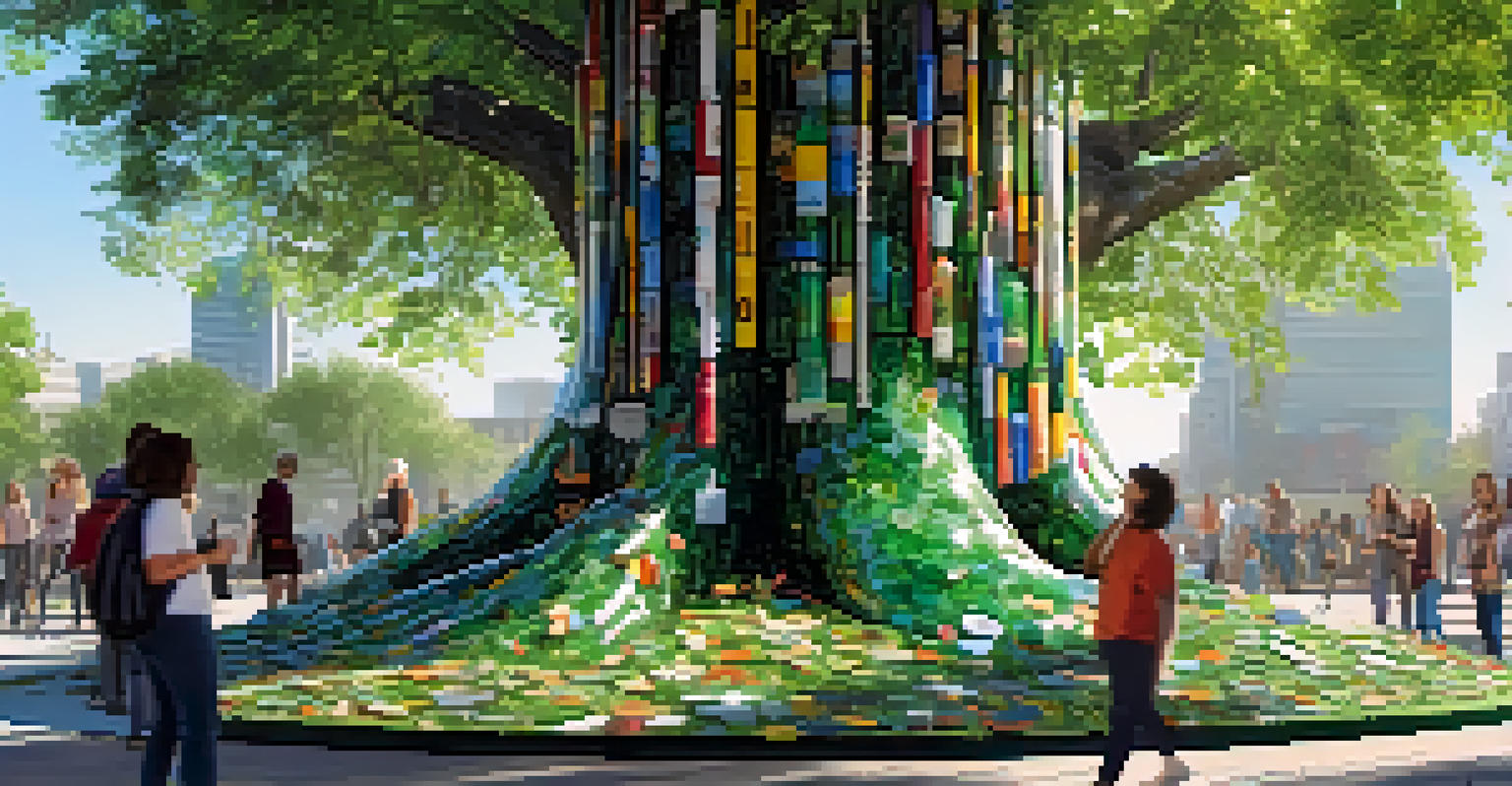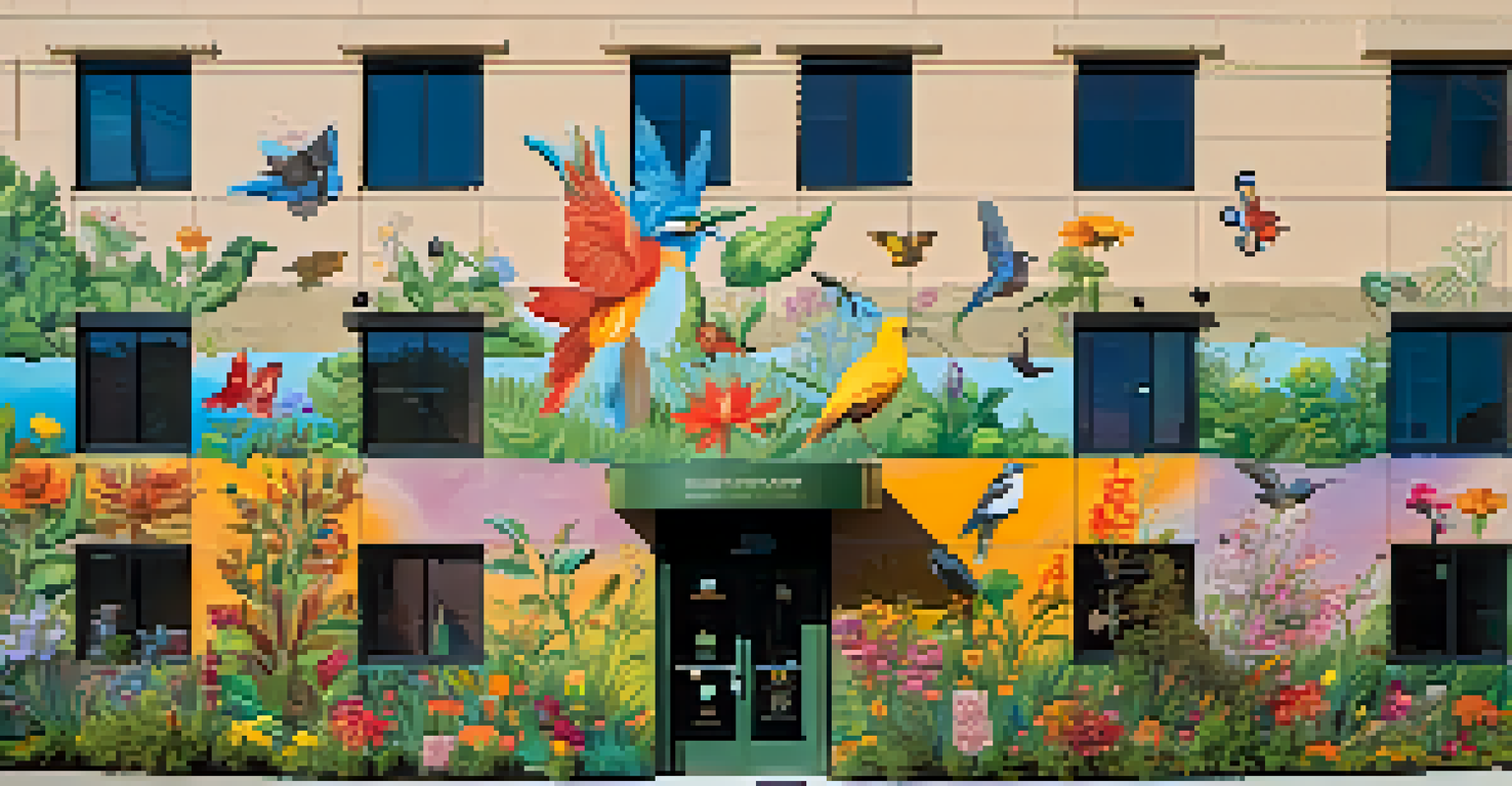Exploring Environmental Art: A Catalyst for Eco-Consciousness

What is Environmental Art and Its Purpose?
Environmental art is a creative movement that emphasizes the connection between art and the natural world. It seeks to raise awareness about environmental issues and encourages a deeper appreciation for the planet. By integrating natural elements into art, creators aim to foster a sense of responsibility towards nature.
Art is a way of recognizing oneself in the other, and in this instance, it is a way of recognizing the interconnectedness of all life.
This genre often uses materials sourced from the environment itself, such as soil, wood, and water, creating pieces that are both beautiful and thought-provoking. For example, artists like Andy Goldsworthy use natural materials to create temporary installations that highlight the beauty and fragility of nature. These works invite viewers to reflect on their relationship with the environment.
Ultimately, environmental art serves as a catalyst for change, prompting audiences to think critically about their impact on the earth. It encourages a dialogue about sustainability and inspires individuals to take action in their own lives.
The Role of Artists in Environmental Activism
Artists have a unique ability to communicate complex ideas in ways that resonate emotionally with people. Many environmental artists use their platforms to advocate for ecological preservation and social justice, making their work a powerful tool for activism. By intertwining art with activism, they can spark conversations and bring attention to pressing environmental issues.

For instance, the works of Olafur Eliasson often explore climate change and its effects, creating immersive experiences that encourage viewers to engage with these critical topics. His installation, 'The Weather Project,' at the Tate Modern, invited visitors to reflect on their relationship with the environment and the changes it is undergoing.
Art Connects Us to Nature
Environmental art fosters a deeper appreciation for the planet by integrating natural elements and encouraging responsibility towards nature.
By combining artistry with advocacy, these creators not only raise awareness but also inspire action. Their work serves as a call to arms, urging society to take a closer look at their environmental footprint and the importance of sustainability.
How Environmental Art Influences Public Perception
The impact of environmental art extends beyond the gallery walls; it influences public perception and attitudes towards nature. Through visually striking and thought-provoking pieces, artists can alter the way we think about environmental issues. For example, large-scale installations in public spaces can draw in casual observers and prompt them to consider their own environmental responsibilities.
The best way to predict the future is to create it.
Public art projects, such as the 'Trash Island' installation in San Francisco, use humor and creativity to shine a light on waste management and pollution. By engaging the community, these projects foster dialogue and encourage collective responsibility for the environment.
As viewers interact with these artworks, they often leave with a renewed sense of purpose and a desire to make positive changes in their lives. Environmental art has the power to transcend cultural barriers, making it a vital tool in shaping societal attitudes toward sustainability.
Case Studies: Successful Environmental Art Projects
Several environmental art projects have successfully brought attention to ecological issues while inspiring community involvement. One notable example is the 'Land Art Generator Initiative,' which encourages artists and engineers to design renewable energy infrastructures that are also aesthetically pleasing. This initiative combines creativity with functionality, highlighting the potential for art to contribute to sustainability.
Another impactful project is the 'Before I Die' wall, where people from around the world share their aspirations and dreams. This interactive art installation encourages reflection on personal values, including environmental stewardship. By inviting community members to participate, it creates a shared sense of purpose.
Artists as Environmental Advocates
Artists use their work to raise awareness about ecological issues, inspiring audiences to reflect on their environmental impact and take action.
These case studies illustrate how environmental art can engage communities, raise awareness, and promote action. They serve as powerful reminders of the role art can play in shaping a more sustainable future.
The Intersection of Technology and Environmental Art
Technology is increasingly becoming a part of environmental art, allowing artists to explore new mediums and reach wider audiences. Digital art, augmented reality, and interactive installations are just a few ways artists are pushing the boundaries of traditional environmental art. This intersection of technology and art can create immersive experiences that captivate and educate viewers.
For instance, artists like Jennifer Steinkamp use digital projections to create mesmerizing displays of nature that respond to real-time environmental data. By integrating technology, they can convey complex messages about ecological change and engage audiences on multiple levels.
This fusion of art and technology not only enhances the viewer's experience but also broadens the reach and impact of environmental messages. As artists continue to innovate in this space, they create new opportunities for dialogue and action around pressing environmental issues.
Environmental Art as a Tool for Education
Environmental art plays a vital role in education, providing a unique approach to learning about ecological issues. By integrating creativity into educational settings, art can help students engage with complex topics in a more relatable way. Art projects can serve as hands-on learning experiences that foster a deeper understanding of sustainability and environmental science.
For example, community art projects that involve local schools can instill a sense of environmental responsibility in young people. When students participate in creating murals or sculptures that reflect local ecosystems, they develop a personal connection to their environment. This experiential learning approach can leave a lasting impact.
Education Through Environmental Art
Environmental art enhances educational experiences by engaging students in hands-on projects that promote sustainability and eco-consciousness.
Ultimately, environmental art can enrich educational curricula by promoting critical thinking and encouraging students to explore solutions for current ecological challenges. It empowers the next generation to become informed advocates for the planet.
The Future of Environmental Art and Eco-Consciousness
As we look to the future, the role of environmental art will continue to evolve alongside growing ecological concerns. With climate change and environmental degradation becoming increasingly pressing issues, artists will play a crucial role in shaping public discourse around these topics. The ability of art to evoke emotion and spark conversation makes it an invaluable tool for inspiring eco-consciousness.
Emerging artists are already experimenting with new materials and technologies, creating innovative works that challenge our perceptions of nature and sustainability. As our understanding of environmental issues deepens, we can expect to see even more impactful art that pushes boundaries and encourages action.

In conclusion, environmental art is not merely a form of expression; it is a powerful catalyst for eco-consciousness. By engaging audiences and inspiring change, it holds the potential to transform how society views and interacts with the natural world.